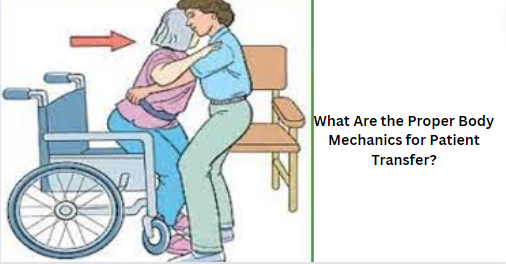
What Are the Proper Body Mechanics for Patient Transfer?
Patient transfer is a routine yet crucial aspect of healthcare, particularly in settings like hospitals, nursing homes, and home care. It involves moving patients from one place to another, such as from a bed to a wheelchair or from a wheelchair to a stretcher.
Proper body mechanics during patient transfer are essential to prevent injury to both patients and healthcare providers.
In this blog, we’ll delve into the importance of proper body mechanics, discuss the risks associated with improper techniques, outline the correct methods for safe patient transfer, and explore additional considerations for specific patient populations.
Importance of Proper Body Mechanics
Proper body mechanics play a pivotal role in ensuring the safety of both patients and healthcare providers during patient transfer. It involves using the body in an efficient and coordinated manner to reduce the risk of strain and injury.
By employing correct body mechanics, healthcare providers can minimize physical stress on their muscles and joints, thus lowering the likelihood of musculoskeletal injuries such as strains, sprains, and back pain.
Moreover, proper body mechanics not only protect the healthcare provider but also ensure the comfort and dignity of the patient. A smooth and safe transfer promotes the patient’s sense of security and trust in their caregivers, contributing to overall satisfaction with their healthcare experience.
Risks of Improper Techniques
Failure to adhere to proper body mechanics during patient transfer can lead to various adverse outcomes for both the patient and the healthcare provider. Some of the risks associated with improper techniques include:
1. Patient Injury: Improper lifting or transferring techniques can result in patient falls, skin tears, or other injuries. Patients who are frail, obese, or have limited mobility are particularly vulnerable to harm during transfer.
2. Healthcare Provider Injury: Healthcare providers may sustain injuries such as strains, sprains, or herniated discs when lifting or moving patients incorrectly. These injuries can have long-term consequences, affecting their ability to perform their duties and diminishing their quality of life.
3. Deterioration of Patient’s Condition: Rough handling or improper transfer techniques can exacerbate existing medical conditions or cause discomfort to the patient, leading to increased pain, anxiety, or agitation.
4. Legal and Ethical Implications: Healthcare facilities and providers have a duty of care to ensure the safety and well-being of their patients. Failure to implement proper transfer techniques may result in legal liability or ethical concerns regarding negligence in patient care.
Correct Methods for Safe Patient Transfer
To mitigate the risks associated with patient transfer, healthcare providers should adhere to the following principles of proper body mechanics:
1. Assess the Patient: Before initiating the transfer, assess the patient’s condition, mobility level, and any potential obstacles or hazards in the environment. Communicate with the patient to ensure their cooperation and understanding throughout the transfer process.
2. Use Assistive Devices: Whenever possible, utilize assistive devices such as transfer belts, slide sheets, or mechanical lifts to facilitate safe patient transfer. These devices reduce the physical strain on healthcare providers and enhance the safety and comfort of the patient.
3. Maintain Proper Alignment: When lifting or moving a patient, maintain proper alignment of your body to minimize stress on your muscles and spine. Bend your knees, not your waist, and keep your back straight throughout the transfer. Avoid twisting your torso or leaning excessively to one side.
4. Engage Core Muscles: Activate your core muscles, including the abdominal and back muscles, to provide stability and support during patient transfer. Keep your feet shoulder-width apart for a stable base of support, and avoid overreaching or stretching beyond your limits.
5. Use Smooth, Controlled Movements: Lift or transfer the patient using smooth, controlled movements, avoiding sudden jerks or pulls that may destabilize them. Communicate with your colleagues to coordinate your actions and ensure a synchronized transfer process.
6. Seek Assistance if Needed: If the patient’s weight or condition exceeds your ability to safely transfer them alone, seek assistance from additional healthcare providers or use mechanical aids as appropriate. Never attempt to lift or move a patient beyond your physical capabilities.
7. Provide Post-Transfer Care: After completing the transfer, ensure that the patient is comfortable and properly positioned in their new location. Address any immediate needs or concerns and document the transfer process in their medical records per institutional protocols.
Additional Considerations for Specific Patient Populations
While the aforementioned principles apply to patient transfer in general, certain patient populations may require additional considerations:
1. Pediatric Patients: When transferring pediatric patients, take into account their smaller size and fragility. Use pediatric-specific equipment and techniques to ensure their safety and comfort during transfer.
2. Geriatric Patients: Older adults may have decreased mobility, balance, and cognitive function, increasing their risk of falls during transfer. Exercise patience and caution when assisting geriatric patients, and provide extra support as needed.
3. Bariatric Patients: Patients who are obese or morbidly obese present unique challenges during transfer due to their weight and body shape. Utilize specialized equipment and techniques designed for bariatric patients to minimize the risk of injury to both the patient and healthcare providers.
4. Patients with Disabilities: Patients with physical or cognitive disabilities may require customized transfer techniques and accommodations based on their individual needs and abilities. Collaborate with the patient and their caregivers to develop personalized transfer plans that prioritize safety and comfort.
Conclusion
Proper body mechanics are fundamental to the delivery of safe and effective patient care, particularly during patient transfer. By understanding the principles of biomechanics, assessing patient needs, and employing appropriate techniques, healthcare providers can mitigate the risks associated with improper transfer practices and promote positive outcomes for both patients and caregivers.
Continued education and training in proper body mechanics should be prioritized within healthcare settings to ensure consistency and proficiency among staff members. Additionally, fostering a culture of collaboration and open communication encourages healthcare providers to seek assistance when needed and prioritize the well-being of their patients above all else.
Ultimately, patient transfer is not just a physical task but a cornerstone of compassionate and dignified care. By embracing the principles of proper body mechanics, healthcare providers can uphold the highest standards of professionalism and contribute to their patient’s overall safety and satisfaction.
You May Also Like

Predicting What Claude 3’s Position, on the LLM Leaderboard Reveals
March 26, 2024
Unraveling the Quirky World of Qureka: A Banner of Innovation and Entertainment
January 9, 2024

